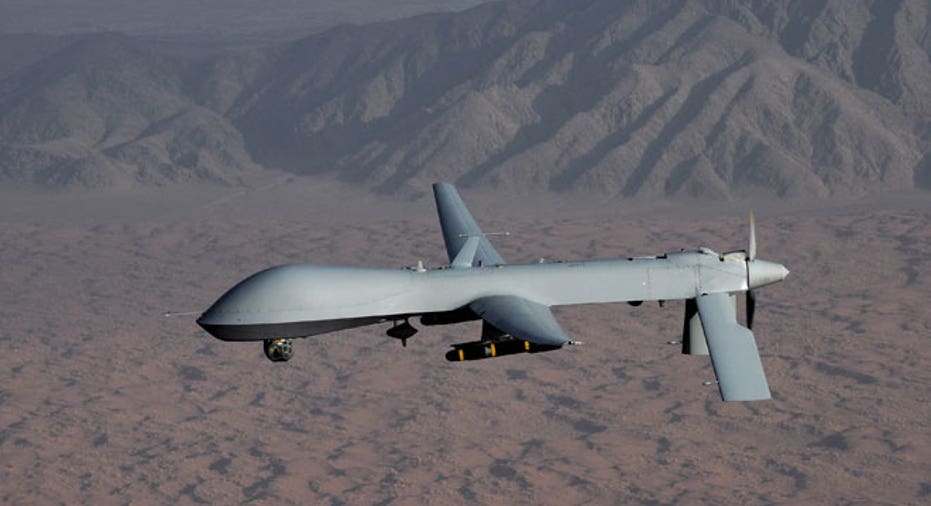Domestic Drones: Pipedream, or the Next Big Thing?

The potential home market for Unmanned Aerial Vehicles (UAVs) could be an attractive opportunity to offset cuts in military spending for defense and aerospace companies.
Currently, there is a national ban in place for the commercial use of UAVs with the FAA scheduled to lift this ban and open the market in September 2015. Hopes for a $90 billion market are pinned to the national airspace actually becoming exploitable, but the road to domestic sales seems increasingly littered with obstacles.
For starters, the FAA will need to meet congressional guidelines and deadlines – and thus far, it is already behind schedule. Domestic drone test sites were due to be established by the end of last year under the FAA Modernization and Reform Act of 2012.
Citing assessment of privacy concerns, the FAA missed the deadline.
On Valentine’s Day, the agency announced it is seeking proposals from states, universities and other organizations for the six test sites.
When you throw escalating surveillance fears rhetoric into the mix with the FAA already behind on the roadmap to opening the market, then full integration of unmanned aircraft systems into U.S. airspace by September 2015 is looking dubious.
Privacy Debate Dominates UAV Discussions
In the past few weeks, the hullabaloo has kicked into high gear, conflating a debate over UAVs into one about surveillance and privacy in general.
With drone-phobia on a trajectory to intensify further, companies will need to address public perceptions, misconceptions and concerns.
In Congress, a bipartisan bill that would require law enforcement officials to obtain warrants before deploying drones for surveillance in criminal cases has been introduced.
State legislatures from all over the country have been ratcheting up tensions surrounding UAVs.
Bills on domestic surveillance drones have already been introduced by many states including Maine, Virginia, Florida, Montana, Missouri, Nebraska, North Dakota, Oklahoma, Oregon and Texas. (Florida, Virginia and Montana appear to be in the lead for turning bans into law.)
Charlottesville, Virginia, grabbed headlines passing its two-year moratorium on both police drone use in criminal investigations and on arming drones with less-lethal weapons.
More than two years in advance of the scheduled ban lift, 10 states have already passed, or introduced, bills restricting law enforcement’s use of drones. It looks like even more states will follow suit.
Flight of the Customer Base
The potential client base of first responders in the United States is vast. The anticipated market includes tens of thousands of police, fire and other government agencies like the forest service.
While these potential customers’ budgets may vary greatly, UAVs are available with an equally wide spectrum of capabilities and range of price points starting at just a few hundred dollars.
On February 7, the FAA released the list of those applying for permission to fly UAVs in US airspace. Of the 81 public entity applicants, 17 were police and sheriff departments.
Law enforcement applicants included Florida’s Miami-Dade, Texas’ Arlington, and Washington’s King’s County.
Earlier this month, Seattle surrendered to the drone hoohah when Mayor Mike McGinn announced the two 3.5-pound Dragonflyer X6 Helicopter Tech drones purchased with a federal Homeland Security grant would be returned to the vendor.
The police had hoped the Dragonflyers could be used for search and rescue, hostage situations and supporting public assistance in natural disasters.
Seattle PD, along with dozens of other law enforcement agencies and academic institutions, had previously received FAA approval to train UAV operators.
Pilot programs using UAVs in national airspace from border patrol support to Miami-Dade Police Department surveillance of the Everglades have been very successful. So much so that in August 2012, the Department of Homeland Security put out a Broad Agency Announcement seeking UAVs for testing this year against conditions on the border with Mexico.
Academic institutions have also made use of UAVs to support their local communities with environmental protection and more.
Utah State University, for example, has been operating a fleet of homemade UAVs that play an important role supporting wetland preservation as well as improving water resource management for agriculture.
Re-branding Beyond Surveillance and Lethality
While it may be impossible to ascertain amidst the sound and fury of anti-drone advocates, the potential applications in national airspace go well beyond surveillance.
UAVs are a useful tool to reduce risk to human life and to support operations saving human lives. In dangerous situations, where a pilot or first responder may be at risk, UAVs can be very handy.
Supporting emergency services, UAVs can monitor large areas and when equipped with bells and whistles like thermal imaging cameras, can improve rapid locating and assistance of, say, a missing child in a national forest.
While helicopters are often used for these sorts of operations, UAVs could provide a cheaper alternative and remove the risk to human pilots. UAVs can also reach places manned aircraft cannot.
In mountain search and rescue mission for example, a manned aircraft may not be able to safely conduct searches into low clouds, but an unmanned could.
UAVs are regularly deployed to conduct aerial surveys and mapping particularly in dangerous terrain by the oil, gas and mining industries.
Saving time and money in agriculture, UAVs are used for crop spraying, water resource evaluation and livestock monitoring in other countries.
Another possible domestic application could be using the technology to ensure essential services that affect the daily lives of civilians such as monitoring the integrity of power lines, railways, pipelines and cables.
Other countries like Australia have succeeded in introducing UAVs into their airspace with far less drama.
Currently, no formal qualifications are required to fly a drone if it is used for recreational purposes there. Commercial operators must be certified under Civil Aviation Safety Authority regulations and there are about two-dozen authorized operators.
The Australian solution has been that in the absence of special permission, all UAVs must fly below 400 feet within the operator’s line of sight in clear weather conditions. Flight is restricted to unpopulated areas.



















